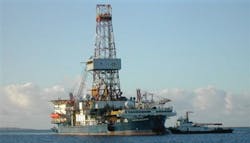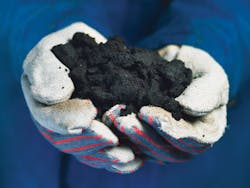Shell wins conditional approval to explore Beaufort Sea
The Department of the Interior's Minerals Management Service (MMS) has approved, with conditions, Shell Offshore Inc.'s Exploration Plan to explore two leases in the Beaufort Sea.
The two leases were obtained by Shell Offshore Inc. during Beaufort Sea oil and gas lease sales 195 and 202 in 2005 and 2007. The sales were included in the 2002-2007 five year oil and gas leasing program and are not affected by the recent court decision on the current leasing program, which sent the 2007-2012 program back to MMS for additional analysis under section 18 of the Outer Continental Shelf Lands Act.
Shell proposes to drill two exploration wells during the July-October 2010 open water drilling season. The drilling operations would be conducted using the M/V Frontier Discoverer, a modern drillship retrofitted and ice reinforced for operations in arctic OCS waters.
Shell's plans include a mid-drilling season break in activities and removal of the drillship from the area to accommodate fall subsistence bowhead whaling by the Native Villages of Kaktovik and Nuiqsut. Specifically, all operations would be suspended beginning August 25, 2010, and all vessels would proceed from the project area to the northwest during the whale hunts, or would leave the Beaufort Sea entirely. Activities may be resumed after completion of the subsistence hunts and extend through October 31, 2010, depending on ice and weather.
Prior to any drilling activities taking place, the plan must be consistent with the Alaska Coastal Zone Management Program and Shell must obtain an approved Application for Permit to Drill from the MMS. Shell must also meet various air and water quality rules as well as marine mammal protection requirements.
MMS Director Liz Birnbaum stated, "Now that we have approved Shell's plan and reached this important milestone, we will continue to work with Shell to ensure that all activities are conducted in a safe and environmentally responsible manner."
Photo courtesy of Shell
Shell's plan is limited to the far western area of Camden Bay, including the use of one drillship with one tending ice management vessel. The two leases are about 16 and 23 miles north of Point Thompson, Alaska.
The Beaufort Sea is estimated to contain 8.22 billion barrels of oil and 27.64 trillion cubic feet of natural gas (undiscovered technically recoverable mean estimate).
After promising Bakken well, Brigham Exploration set to raise $137M to grow Williston Basin drilling
After Brigham Exploration Co.'s operated Brad Olson 9-16 #1H (Brad Olson) produced roughly 2,112 barrels of oil equivalent per day (boe/d) from the Bakken formation during an early 24 hour flow back period, the company is looking to accelerate its drilling program in the Williston Basin.
The well appears to be the first 28 stage fracture stimulation completed in the Williston Basin and the fifth overall 18+ stage fracture stimulation completed by Brigham in the Williston Basin.
The Brad Olson was successfully fracture stimulated and while Brigham was drilling out frac plugs the well produced approximately 1,805 barrels of oil and 1.84 MMcf of natural gas from the Bakken formation during a 24 hour period.
The Brad Olson is located in Williams County, North Dakota in Brigham's Rough Rider project area and is roughly 1,500 feet from the Olson 10-15 #1H, which was completed with 20 fracture stimulation stages in early February 2009 at an early 24 hour production rate of 1,433 boe/d.
The company maintains an approximate 33% working interest and 26% net revenue interest in the Brad Olson. Also participating in a non-operated role in the well is US Energy Corp. with an approximate 61% working interest and 48% net revenue interest. Brigham will back in after combined payout of the six initial wells drilled under the agreement with US Energy for 35% of their interest in the well.
Bud Brigham, the company's chairman, president and CEO, stated, "The Brad Olson 9-16 #1H is yet another data point that confirms our belief that our Rough Rider area should be considered core acreage within the Williston Basin."
With two Brigham operated rigs currently drilling in the Williston Basin, Brigham anticipates adding a third operated rig later shortly, and a fourth operated rig early in the third quarter 2010.
At presstime, the company began a proposed underwritten public offering of 16,000,000 shares of common stock in hopes of raising over $137 million to accelerate the development of the company's Williston Basin acreage position. The company hopes to drill 24 net horizontal wells, including 21 net operated wells and three net non-operated wells, in 2010, which will target both the Bakken and Three Forks objectives.
Following the successful offering, Brigham expects its initial 2010 exploration and development budget to be roughly $175.8, including $169.4 million in drilling expenditures and $6.4 million in land expenditures.
A portion of the net proceeds are expected to help repay debt. As of September 30, 2009, $110 million was outstanding. Brigham plans to re-borrow under its senior credit facility in 2010 to fund exploration and development expenditures.
Brigham stated, "By adding a third rig later this month and a fourth rig early in the third quarter 2010, we can accelerate our activity and exploit the currently advantageous environment presented to us in terms of favorable commodity pricing, reduced levels of service costs and reduced product differentials."
Credit Suisse Securities (USA) LLC and Jefferies & Co. Inc. are acting as joint book-running managing underwriters and Johnson Rice & Co., Raymond James, RBC Capital Markets, Howard Weil Inc. and Pritchard Capital Partners LLC are acting as co-managing underwriters for the offering. After Brigham upsized its proposed 14 million share offering to 16 million shares at $10.50 per share, SMH Capital upgraded the company from Neutral to Accumulate.
– Mikaila Adams
Marathon makes Tebe discovery in Deepwater Angola
Marathon Oil Corp.'s subsidiary, Marathon International Petroleum Angola Block 31 Ltd., has participated in the deepwater Tebe discovery well in the southern portion of Block 31 offshore Angola.
The Tebe discovery well is located roughly seven miles southeast of the Hebe discovery announced in October 2005 and roughly 220 miles northwest of Luanda, Angola.
The well was drilled in a water depth of nearly 5,700 feet and reached a total measured depth of roughly 11,400 feet. Well test results confirmed the capacity of the reservoir to flow in excess of 5,000 b/d. The PSVM development is proceeding with first production targeted in 2012.
The concessionaire of Block 31 is Sonangol. Marathon holds a 10% interest in Block 31. The operator is BP Exploration (Angola) Ltd. with 26.67%. Other interest owners are Esso E&P Angola (Block 31) Ltd. with 25%, Sonangol P&P with 20%, Statoil Angola AS with 13.33%, and TEPA (BLOCK 31) Ltd., a subsidiary of the Total Group with 5%.
ExxonMobil, Det norske spud Jetta in North Sea
Det norske has started drilling the Jetta Prospect in Production License 27D, south of Jotun. ExxonMobil is operator for the license.
Because it lies close to existing infrastructure (Jotun), the prospect could be developed quickly if discoveries are made. Det norske is currently drilling three exploration wells.
Det norske has bought up interests in Jetta, a prospect extending across three licenses, and the company's interests now amount to roughly 50% (47% in PL 027D, 58.5% in PL 504 and 57% in PL 196C). Through an agreement with ExxonMobil, Det norske increased its interest in PL027D to 47% this summer, in return for carrying the costs of ExxonMobil's 13% interest relating to the Jetta well.
The Jetta Prospect will be drilled using Bredford Dolphin with Det norske as drilling operator.
Newfield partners with Hess to explore white-hot Marcellus
Newfield Exploration Co. and Hess Corp. have signed a joint exploration agreement in the Marcellus shale play. The agreement covers up to 140,000 gross acres primarily in Susquehanna and Wayne Counties, Pennsylvania. Newfield will operate the new venture with each company having a 50% interest.
New territory
The venture marks Newfield's entry into the Marcellus shale, a play noted by Lee K. Boothby, Newfield president and CEO, to "likely" become one of the nation's largest natural gas resource plays. "Today, with substantially all of our acreage held-by-production in the Woodford shale, it's a great time for us to enter an important new focus area and apply our expertise to a similar play of scale."
Newfield has focused much of its recent energy on the Woodford shale. The company was featured as a Top 2008 Woodford Producer in the August issue of Oil & Gas Financial Journal. The company has amassed 165,000 net acres since entering the play in 2003. Roughly 300 horizontal wells have been drilled in the area with a resulting current gross operated production capacity of nearly 300 MMcfe/d.
The 2009 portion of Newfield's Marcellus shale activities will be funded within the company's existing $1.45 billion capital budget. Drilling operations are not expected to begin until 2010.
Greg Hill, president of worldwide exploration and production for Hess believes the company is set to build on the unconventional expertise the company has from its operations in North Dakota's Bakken play, noting the company's "established technical capability in horizontal, multi-stage fractured wells" and "sound environmental operating practices"—something the pair may have to draw upon. Just six permits were issued in Susquehanna County versus 13 in August, potentially due to environmental issues, noted Pritchard Capital Partners.
September drilling permits
Despite concerns about natural gas storage—EIA reports for the week of October 5 noted storage injection of 69 bcf, putting total storage at an estimated 3.658 tcf, 15% above its five-year average— the Marcellus shale play has been a hotbed of activity.
An update from Pritchard Capital Partners notes drilling 184 horizontal permits issued in the play in September versus 91 in August.
The counties with the highest number of horizontal drilling permits in September were Bradford County (36), Tioga (31), Washington (23), Clinton, (15), Lycoming (14), Greene (14) and Lackawanna (11).
Terms of the transaction are dependent upon the companies finalizing additional agreements over the next few weeks.
– Mikaila Adams
Baker Hughes achieves 24-stageopen isolation in Bakken shale
Baker Hughes successfully ran a 24-stage completion in the Williston Basin for Whiting Petroleum Corp. This is among the largest number of stages ever run using a ball/sleeve method for isolation. The Baker Oil Tools FracPoint™ EX multistage fracturing system (FracPoint EX) used on the Ogden 11-3H well allowed the single-trip isolation of 24 intervals with an 8,000-psi pressure rating, while achieving high frac rates through all the ball seats.
According to Bob Bennett, president of Baker Hughes' Baker Oil Tools product line, "Lowering operating costs and increasing completion performance are top priorities for operators, given our current market environment. We believe our new system, which builds on the success and reliability of Baker Hughes' original FracPoint system and sets a new standard for downhole tool providers, will meet our clients' expectations in areas like the Bakken Shale and Three Forks where demand is increasing for the number of stages on a single-trip open-hole completion."
Rick Ross, vice president of operations for Whiting Petroleum said, "As our ability to efficiently drill and complete longer horizontal laterals has increased, the need to increase the number of frac stages that can be pumped with a ball/sleeve system has become critically important to Whiting. Our relationship with Baker Hughes in North Dakota has resulted in the companies jointly pushing technology for more effective and efficient completions."
The Bakken Shale/Three Forks play in North Dakota has seen an increase in activity due to fracturing improvements using multistage open-hole packer and sleeve systems. Advances in completion product development are enabling Baker Hughes to develop increasingly more complex fracturing systems that can be deployed in one trip, reducing the steps required to successfully complete a well.
Baker Hughes said the original FracPoint multistage system is highly effective for precisely and reliably isolating multiple stages in open holes while eliminating the costs and complexities of cementing and perforating. The FracPoint EX multistage fracturing system extends the FracPoint system's capability to 24 stages. This job was the first 24-stage FracPoint EX system Baker Hughes has deployed globally.
Nostra Terra hits hydrocarbons at Boxberger property in Kansas
Nostra Terra Oil & Gas Co. PLC has made a hydrocarbon discovery on the Boxberger property in Kansas.
The Boxberger A #5 horizontal well in Russell County, Kansas is Nostra Terra's initial production well in the area. The well is a re-entry. It was originally drilled to a total measured depth of 3,400 feet. The company is drilling multiple laterals in two un-produced zones in lengths of 300 feet to 600 feet each.
Details on flow rate will be provided once production is established.
Nostra Terra currently holds a 75% working interest before payout and 50% after payout in this well. Hewitt Petroleum Inc. (HPI) holds the remaining interest.
"We have encountered two reservoirs that have never been produced before," said William A. Alexander, a consulting engineer based in Broken Arrow, Okla. The project culminates a five-year research effort designed to identify bypassed reserves in the Central Kansas Uplift. The field where Boxberger is located is one of the largest in Kansas having produced almost 100 million barrels of oil in various zones since its discovery in 1926.
StatoilHydro's Frigg Delta area in North Sea yields more crude
Oil has been discovered by StatoilHydro in the Frigg Delta prospect in the North Sea, with proven recoverable volumes put at 18-35 million barrels. The find is located roughly 13 miles east of the abandoned Frigg field and 7.5 miles north of Froy.
"It's commercially interesting, and we've already started looking at prospects for a development linked to nearby oil resources," said Tom Dreyer, head of infrastructure-led exploration in the North Sea.
The discovery well encountered oil in sandstone of good reservoir quality belonging to the Frigg formation.
"Our starting point has been an old unclarified find in this formation," explained Dreyer. "An analysis of this, combined with new seismic data, put us quickly on the track of the oil we've now proven in Frigg Delta."
The total potential recoverable volume in this discovery and the nearby Frigg Gamma and Frigg Epsilon reservoirs is in the order or 62-189 million barrels of oil equivalent. The Ocean Vanguard semisub, responsible for the discovery, will now redeploy to the Norwegian Sea to drill an exploration well on the Floien prospect also operated by StatoilHydro.
In addition to the group with 40%, licensees in production license 442 covering Frigg Delta are Svenska Petroleum Exploration with 40% and Det Norske with 20%.
Ziff completes oil sands studyfor Canadian oil sands properties
Calgary-based Ziff Energy Group has completed its first Steam Assisted Gravity Drainage (SAGD) Drilling Benchmark Study, which provides an independent, detailed analysis of the drilling and completions cost on SAGD (also called "in-situ") and delineation wells for oil sands properties in the Western Canadian Sedimentary Basin for the four-year period, from late 2004 to the fall of 2008. The study assessed 159 SAGD well pairs and 1,833 delineation wells that cost a total of $1.04 billion. Clients of the study included five international and two Canadian operators.
A common method of producing oil from bitumen when a deposit is too deep to mine is SAGD, which is more environmentally benign than oil sands mining. The approach involves drilling two parallel horizontal wells – one above another with a typical 5-meter separation – as a well-pair. A well-pair consists of a top well, the steam injector, and a bottom well, the producer. Anywhere between 4 and 20 well-pairs are drilled on a particular section of land, or pad. The 5-meter separation has been proven to be the optimal gap that allows for maximum reservoir production due to the most effective impact of the injected steam. The study found that although the separation between injector and producer wells is planned for 5 meters, some wells had as high as 8- to 9-meter gaps at some points, reducing production capability from that particular zone.
SAGD Projects are attractive to producers (as compared to oil sands mines), as the SAGD process can access deeper formations and can be developed on a smaller scale (and in phases), which sharply reduces the capital at risk, and the engineering and construction risk. Therefore, far smaller producers can undertake a SAGD project, and there are many more SAGD projects than mines. SAGD production will overtake mining production by 2030 (Source: Ziff Energy Gas Services Group).
This initial study provides valuable insight into both SAGD producer and injector well costs and drilling performance, with similar insight for the delineation programs (cored and non-cored wells). In fact, of the $1.04 billion spent, over half was spent on the delineation programs.
Benchmarking the performance and cost structure of SAGD drilling allowed study participants to:
- directly compare their drilling cost performance to peers
- learn technical best-practices to capitalize on prior lessons learned, thereby gaining efficiencies
- gain the important component to benchmarking – unbiased cost comparison.
More Oil & Gas Finacial Journal Current Issue Articles
More Oil & Gas Financial Journal Archives Issue Articles



